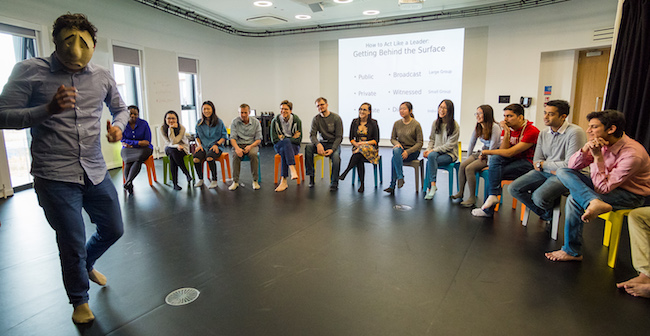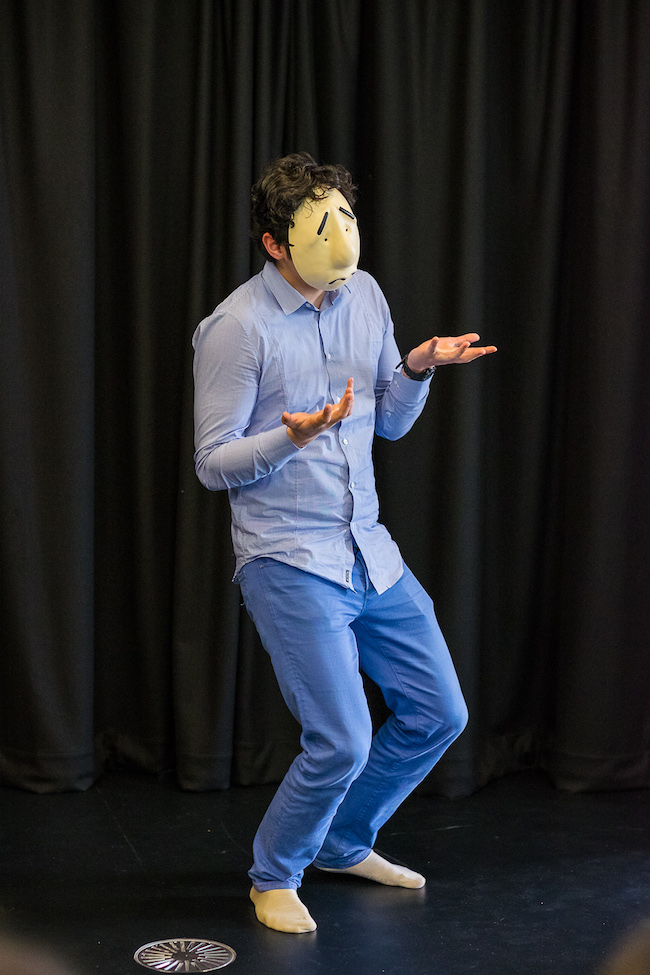
Students in Create Space learn about facial recognition and the perception of emotion. Courtesy photo
‘WHAT DO PEOPLE HEAR WHEN YOU SAY THINGS?’
“One of the things we’re charged with is to try to transform the teaching methodology across the school,” he says, “so we’re looking for pedagogic innovation generally — for instance, dramatization of case studies is one type of thing that we’re tackling, taking a Harvard case and figuring out where your presenting case is in dramatized form. That way you can get inside them in a sense, you can enact them and embody them so that they are not just exercises in teaching technical points on a syllabus.”
Some of the most interesting work done in Create Space has involved masks. An exercise in which a student wears a mask with a set expression but then must convey different emotions offers insight into the control of communication, Ibbotson says, and how roughly two-thirds of one’s message is decided by one’s audience. “People interpret your actions in ways you think you can control, but you can’t,” he says, offering the example of an angry mask that is seen by observers as not intimidating but absurd.
“It is an interesting area, looking at facial recognition and questions about authenticity and how you interpret what people say,” he says. “How does communication actually work? What do people hear when you say things? How do they interpret it in their heads when they hear it? There’s lots of work around that area which we can link in closely to a lot of the core issues in developing business leaders.”
OVER THE THRESHOLD

Courtesy photo
Of course, not all B-school students are immediately on board with the whole “take off your shoes and put on this mask” thing. Finance types — “someone who wants to be a quant” — sometimes resist the unconventional approach, concedes Ibbotson.
“But that’s kind of the point,” he says, adding that he and Jonothan Neelands, associate dean for creativity, and Rachel Dickinson, principal teaching fellow, “very carefully structure all the work that we do — so that we kind of scaffold the journey. Once you’re over the threshold there’s no point (at which) you can’t work with people in a place of resistance, so you have to structure the work so that people can move into it and find themselves in a place where they’re comfortable and secure and feel supported and trusted enough to be able to risk something and find something out.”
Other innovations are planned. Ibbotson wants to bring in someone who flew Apache helicopters in Afghanistan, because in the training of both business and military leaders, “you have a similar approach to how you describe objectives in terms that both deliver the result on time and in the right place, but allow individuals the space to improvise their solutions. There’s an interesting parallel in how you get the best performance out of your people. It’s the same thing, and it’s not just a metaphor.”
All this is just scratching the surface, Ibbotson says. The Create Department is exploring ways to use behavioral science to adjust behavior and study how cognitive bias works. Ibbotson hopes to expand even further the teaching repertoire of Create Space, bringing in movement specialists, painters, artists, and musicians. “At the moment,” he says, “it’s mostly theater-based, but I think there is potential to construct work which will use all of the humanities to explore different aspects of leadership.”
DON’T MISS THE ECONOMIST’S BIG WINNERS & LOSERS and WARWICK NAMES STRATEGY PROF NEW DEAN











Questions about this article? Email us or leave a comment below.